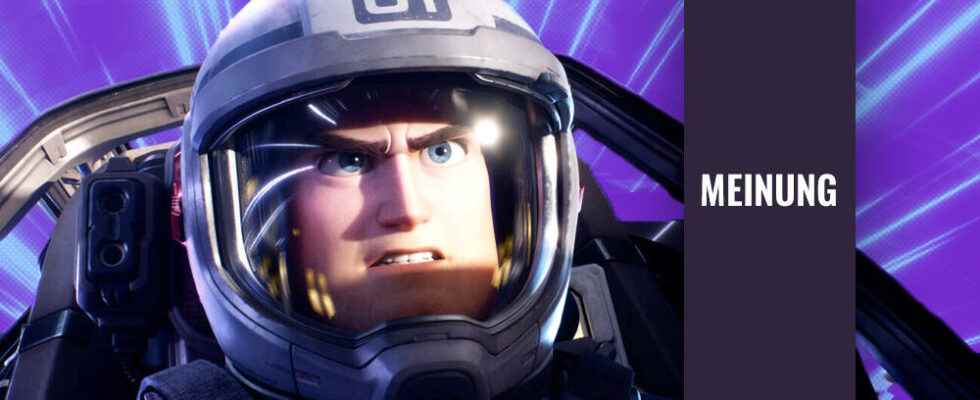With Lightyear, Toy Story fans have had an intergalactic sci-fi adventure in cinemas since this Thursday. Marvel star Chris Evans voices the title character in the original. Pixar’s latest animated prank seeks to transcend time and space. Ultimately, the spin-off only reveals how Disney buries the innovation of the former pioneering studio Pixar under its franchise mania.
Franchise vs. Creativity: Disney’s MCU Success Hurts Pixar’s Imaginative Ideas
Toy Story was Pixar’s first feature film, Lightyear is the most recent. Both animated adventures share the character of space ranger Buzz Lightyear. In 1995 he was still a toy, which came to life. 2022 he is a astronaut with space rescue mission. Both films are linked in the most banal way possible: two sentences at the beginning of Lightyear explain that the following sci-fi excursion was Andy’s favorite film. The Toy Story boy’s toy was (so the retrospective interpretation) based on this film.
Watch the trailer for Toy Story’s Lightyear with Chris Evans’ voice here
Lightyear – Trailer (English) HD
What follows is a science fiction film in which Buzz Lightyear lands on a hostile planet and tries to save his crew using multiple (time travel) flights. In the future, the ruthless robot commander Zurg and a team of untrained amateurs await him. It is a passable space adventure with some Toy Story and even more movie references to the science fiction era of the 1980s and 1990s. Creativity looks different.
Beyond the living toys, Toy Story was the fish-out-of-water story of a selfish plastic toy as opposed to the old-fashioned collectible cowboy doll Woody and his friends. But by telling the Space Ranger’s “movie backstory” from Pixar, Buzz Lightyear actually becomes calculating merchandise.
Despite some nice ideas like petrol crystals, a pushy robotic cat or astrophobia (the fear of space), Disney’s franchise shadow is now on the new Pixar film. It is just the cog of a cinema universe of several loosely linked films, as Disney is already successfully doing with the MCU (Marvel Cinematic Universe). lightyears sole raison d’être rests on the shoulders of a toy from an old popular movie. It brings him to the bitter reality.
Lightyear shows extreme: Sequels have always been Pixar’s weakest films
Whether Star Wars or Marvel: Disney knows about them Traction from established brands. Old successes lure the masses back to the cinema. The corporate giant bought the animation studio Pixar in 2006. Since then, the sequels have multiplied there. How little trust has recently been placed in fresh ideas is shown, for example, by the fact that the last standalone Pixar films (Soul, Luca and Rot) were sold directly at Disney +. That may have been partly due to the Corona situation. But franchise flicks like MCU entry Black Widow (and now Lightyear) made it to the big screen against the odds.
©Disney
Buzz Lightyear’s Avengers?
Unfortunately it was Pixar is always at its weakest when trying sequels, prequels and spin-offs. The Cars series may have its place for children, but the boring adventures of the talking cars are just a merch machine with a humming engine in parts 2 and 3. Neither Finding Dory nor The Incredibles 2 and certainly not The Monsters University could build on the size of their predecessors. Many consider Toy Story 3 to be an exception. But where the originals broke new ground, their successors usually found it difficult to gain new facets from the well-trodden paths.
Good sequels are not impossible. For example, to give Buzz Lightyear a “real” model for the toy along with an animated fictional biopic after Toy Story would have been an unusual idea. The current sci-fi movie but the “special” is missingwhich Pixar always excelled at in its best films.
Marvel, Star Wars and…Toy Story? Disney’s Lightyear copies the wrong recipe for success
When Lightyear takes up familiar elements, it may at first pass as an appreciation of previous space colleagues: The home of villain Zurg is reminiscent of the architecture that Darth Vader preferred for his spaceships. Backlit hero silhouettes in front of hangar doors, talking machines and people in combat robot suits, which Avatar director James Cameron would have approved of, do the rest for the sci-fi flair. At the same time, Lightyear looks like one pale copy of ideas that have already been used up.
©Disney
Lightyear vs. Thanos copy?
Chris Evans, who lends his not at all distinctive voice in the English original Buzz, is probably the most boring voice cast in years. The fact that Captain America is speaking Captain Lightyear once again makes that clear Hidden agenda for a potential animated MCUthat went into this uninspired film at Disney. It can also be no coincidence that James Brolin is now voicing villain Zurg after his son Josh Brolin’s Thanos appearance. Do we already have to fear (quite conceivable) further Toy Story entries like “Woody – A Cowboy Adventure” with Robert Downey Jr. as narrator?
Ironically, the (toy) robotic cat from the Toy Story “prequel” works best as a fun side-kick in the overall picture. However, if that Plastic toy from Toy Story has more life and heart than its human counterpart, the astronaut Buzz Lightyear, then it should be clear that something went wrong here. There is no question as to which of the two is the emotional fake. If only the imaginative toy of our childhood had stayed in its box…
©Disney
Buzz Lightyear with robotic cat Sox
In any case, the story of Lightyear will not take us to (all too often sought) infinity and much further, but will probably only be remembered until next Tuesday. If Pixar continues to align with Disney’s Marvel strategy, times for exciting animated entertainment look bleak. Because creativity takes no franchise corset according to scheme F, but freedomto create your own galaxies.
*This Disney+ link is an affiliate link. By taking out a subscription via this link, you support Moviepilot. .
As Toy Story fans, will you see Pixar’s Disney film Lightyear in the cinema?
